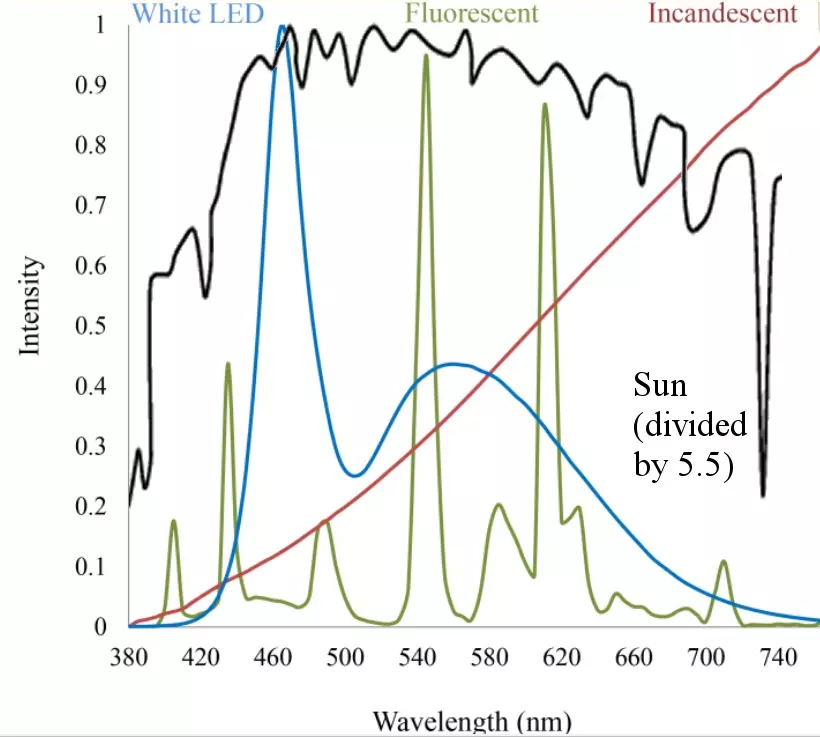[Originally published as LED Lights Might Pose A Hazard for Vision]
A good friend showed me an article from the University of Toledo which reports on a study that demonstrates how blue light might be damaging to the light-sensing cells found in your eye. I didn’t know anything about this, so I decided to look into the research that has been done on the effects of blue light on vision. I found this excellent review article, which discusses what has been figured out so far.
The short answer is that we don’t know anything for certain, but there is some evidence that long-term, chronic exposure to significant amounts of blue light could be damaging to your eyes.
Several animal studies have shown that exposure to blue light can increase the animal’s risk of age-related macular degeneration (AMD) and other eye problems. However, studies on people haven’t been clear. Some studies have shown a relationship between long-term exposure to the sun’s light and AMD, and it is assumed that the blue light given out by the sun is the culprit.
However, a case-controlled study in Australia indicated that it might not be exposure to the sun’s light that is causing the relationship. It indicates that sensitivity to glare and difficulty developing a tan are the actual indicators of higher AMD risk, and studies that show a relationship between the sun’s light and AMD might not be controlling properly for those variables.
The study that was discussed in the University of Toledo article linked above didn’t assess the damage blue light causes to human eyes. Instead, the authors assessed the damage on human cells. However, they didn’t use actual light-sensing cells from a human eye, because that’s not possible. They used HeLa cells, which are a line of cells that came from cancerous tissue taken from a woman named Henrietta Lacks more than 65 years ago. The cells continue to reproduce to this day, so this line of cells is often referred to as “immortal.” The story behind the acquisition of the cells is the topic of a very sad and interesting book as well as a pretty lousy movie.
Since HeLa cells didn’t come from Mrs. Lacks’s eyes, the authors of the study added a chemical to them that is normally found in the eye and is necessary for the light-sensing cells in the eye to work (retinal). Addition of the chemical had no effect on the cells. However, when the cells with that chemical were then exposed to blue light, it resulted in damage to the cells. Exposing the cells to blue light without adding the chemical produced no effect. Thus, the authors conclude that the chemical and blue light are both necessary to cause cell damage. Since the chemical is found with light-sensing eye cells, blue light probably causes damage in those cells.
How worried should people be?

Once again, that’s not clear. Our biggest exposure to blue light comes from the sun. Look at the graph and concentrate on the wavelengths on the left (380-500 nm). Those are the violet and blue wavelengths. Notice that the sun’s light levels off at high intensity right around 465 nm, which is solidly in the blue range. Notice also that in order to be compared to the light given off by artificial sources, the sun’s light intensity had to be divided by 5.5. That’s because the sun’s light is much, much brighter than artificial light.
Now look at the light intensity coming from incandescent lights (the “old-style” light bulbs that use glowing filaments). It is very low in the blue region and highest in the red region (wavelengths of 620-750 nm). So in terms of blue light, incandescent lights aren’t much of a problem. Fluorescent lights are worse, with a strong peak at about 440 nm, which is on the border between violet and blue.
But notice the intensity coming from LEDs. LEDs give you more blue light (450-470 nm) than any other color. That’s why some people are worried. LEDs are used in more and more home lighting applications, since they save money. They are also used in many cell phones and television/computer screens. Thus, when we spend a lot of time looking at those kinds of screens, we are getting more blue light than any other color of light.
As a side note, this is why different light sources look different. They all give you a mixture of many colors, and when many colors are mixed together, we see white. However, you have no doubt noticed that the light coming from an incandescent light bulb looks “warmer” than the light coming from a fluorescent light bulb. That’s because the light from an incandescent light bulb has a lot more red, orange, and yellow. In the same way, LED lights look white, but they seem “bluer” than other light sources because they produce more blue light than anything else. The light coming from the sun has the most “even” mix of colors, so it looks the most white.
So should we be worried about looking at LED screens a lot? Probably. While we don’t really know what the long-term risks are, there is enough evidence to indicate that too much blue light can be a problem. Of course, the sun is shining a lot more blue light at you than any LED screen, because the sun’s light is so intense. However, LED screens are clearly a potent source of blue light, and many people spend a lot more time looking at those screens than being in the sun. You can reduce the severity of the problem, however, because many companies produce blue filters for computer screens and cell phones. There are also blue-light-filtering glasses that you can wear.
Hopefully, more research will eventually indicate what the real threat is from various light sources, but for now, it’s probably best to be overly cautious.






